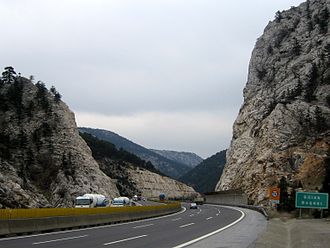Cilician Gate
| Cilician Gate | |||
|---|---|---|---|
|
The Turkish O21 motorway ( European route 90 ) at the entrance to the Cilician Gate. |
|||
| Compass direction | north | south | |
| Pass height | 1290 m | ||
| province | Adana | Mersin | |
| Valley locations | Pozantı | Damlama | |
| expansion | Pass road | ||
| Mountains | Taurus Mountains | ||
| Map (Adana) | |||
|
|
|||
| Coordinates | 37 ° 19 '18 " N , 34 ° 47' 31" E | ||
The Cilician Gate ( Turkish Gülek Boğazı ) is the most important connection between Cilicia and the Mediterranean Sea and the highlands of Anatolia . The gate is a pass through the Taurus Mountains . The southern end is 44 km north of Tarsus . The Cilician Gate is now in the province of Mersin on the border with the province of Adana .
In ancient times the gate was called Kilikia Pylai in Greek (German: the gates of Cilicia). The Crusaders called the gate Porta Judae and the Arabs Darb as-Salāma . The Turkish name was derived from the village Gülek at the southern entrance of the gate. There is also Gülek Kalesi Castle , which controlled the entrance to the gate in the Middle Ages.
The gate was formed by the river Gökoluk and as a path could only be crossed with mounts, but not with vehicles. The pass was partially widened over time. As the strategically most important gateway on the way from Anatolia to Syria, many armies marched through here. So the ten thousand from Xenophon's Anabasis and Alexander the Great , who went from here to the battle of Issus , got through. Under the Roman emperor Caracalla , the path was repaired and widened, as evidenced by a milestone from Podandus . Even Paul of Tarsus and the knights of the First Crusade passed this gate. When the Egyptian viceroy Ibrahim Pasha marched against his Ottoman overlord in 1833 , he also had to pass the gate. In order to transport his cannons, he had to have the narrow path widened, since only one packed camel could pass through at a time.
For the Baghdad Railway , which was supposed to connect Constantinople with Baghdad , the Cilician Gate represented a major obstacle. The rails could not be laid along the old path through the gate because it was too narrow and winding in many places. Therefore a number of viaducts and tunnels were built. These are among the greatest achievements of the German engineers in the course of this project. The line, which was initially operated as a narrow-gauge railway with roller-head traffic , opened in 1918. During the First World War , Ottoman troops were brought to the Mesopotamian front through the Cilician Gate .
Web links
- www.trainsofturkey.com: Cilician Gates Railroad engineering through the Cilician Gates. Retrieved May 16, 2014 .
Footnotes
- ↑ Strabon II 7.9
- ↑ See Martijn Theodoor Houtsma: EJ Brill's First Encyclopaedia of Islam, 1913-1936. EJ Brill, 1987, ISBN 9-004-08265-4 , p. 182.
- ↑ Viam Tauri vetustate conlapsam conplanatis montibus et caesis rupibus ac dilatatis itineribus cum pontibus institutis restituit.
- ^ Richard P. Harper: Podandus and the via Tauri. Anatolian Studies 20, 1970, 149–153 excerpt

